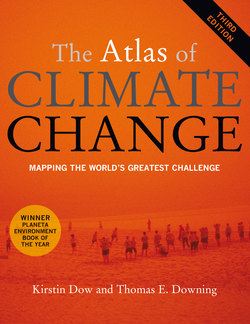Читать книгу The Atlas of Climate Change - Professor Kirstin Dow - Страница 15
На сайте Литреса книга снята с продажи.
Оглавлениеthe market imperatives. Cooperation is also central to designing “fair” solutions, between industrialized nations and least developed countries, or in limiting luxuries such as very large cars while protecting the poor from high transport costs. Cooperation alone is not sufficient: the third level is transformation. This is the more difficult landscape, where new organizations and institutions are required. It may involve replacing entrenched gatekeepers who are preserving their narrow self-interests, while seemingly supporting action on climate change. The ultimate solutions to the challenges ahead require action far beyond adding a bit of sustainability to what we are doing today. The transformative pathways begin in concern for environment (the historic locus of climate change), disaster risk reduction (mostly to cope with climate impacts, but increasingly concerned about planetary futures), and economic investment (from development horizons to technological innovation). The goals of sustainable environments, saving lives and livelihoods, and ending poverty are guiding lights. We believe solutions to the challenges and opportunities of climate change must reflect each of these goals. We encourage you to get involved, in your own lives, in your own, even virtual, communities, and in collective endeavors. Kirstin Dow South Carolina, USA Tom Downing Oxford, UK June 2011
Acknowledgements
Many people have shaped our efforts, here in the Atlas and beyond. We would like to pay homage to champions who have passed away since the first edition of the Atlas. Steve Schneider led the world in many scientific ways and as a champion of informed policy. Bo Lim worked tirelessly to do adaptation, from the first Adaptation Policy Framework to projects around the world. Gilbert White inspired many in pioneering work on sustainability and disasters. We miss them in our lives and in the stage of climate policy. Scientists, interns and assistants around the world have helped on various topics, and this edition builds on the previous versions. Particular contributions to the third edition are noted from Andrew Alberico, Lisa Alexander, Sally Brown, Sujatha Byravan, Greg Carbone, Mark de Blois, Lesley Downing, Kristie Ebi, Mo Hamza, Tomotaka Iba, Sari Kovats, David Lobell, Elizabeth Marino, Karly Miller, Robert Nicholls, David Nimitz Steve Pye, Chella Rajan, David Stainforth, Nassos Vafeidis, Paul Watkiss. And many others who gave us advice, answered emails or made lasting contributions to the data, science and assessments. Many of the websites that provide data have been vastly improved over the past five years. Those behind the scenes of making data reliable and available are often unsung heroes of climate change; they are deeply appreciated. The team at Myriad Editions brought the data to life: Jannet King, Candida Lacey, Isabelle Lewis, Corinne Pearlman. Jonathan Sinclair Wilson, formerly at Earthscan, continues to provide a sharp insight into public understanding of science. A special thanks to Wangari Maathai and Philippe Cousteau. Their forewords speak for themselves; their lives have touched us deeply.
15
